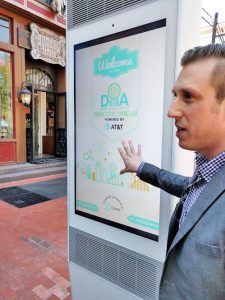![]() Two new 55-inch touchscreens and other smart features unveiled in the West End represent a large leap forward for Dallas’ Smart Cities initiative.
Two new 55-inch touchscreens and other smart features unveiled in the West End represent a large leap forward for Dallas’ Smart Cities initiative.
The screens, which are part of the Dallas Innovation Alliance’s Smart Cities Living Lab, display points of interest, restaurants, parks, and other relevant information to pedestrians. Directions can be sent to your phone via text or email. There’s even a selfie mode.
The kiosk officially went into operation Monday on Market Street in front of the Dallas Entrepreneur Center. It’s the result of a partnership with the city, AT&T, and the Dallas Innovation Alliance, which includes the city of Dallas, Dallas Entrepreneur Center and Dallas Regional Chamber. CIVIQ Smartscape, based in Massachusetts, actually donated the device for the pilot program.
“No one really has the solution that pulls everything together until now,” said Josh Bergland, director of technical services for CIVIQ Smartscape, the company that developed the kiosk. “It’s a data aggregation point. In all reality, what you see here is actually an intelligent edge-based IoT gateway. We really feel there’s a great future value.”

Josh Berglund from CIVIQ Smartscapes shows off the kiosk. [Photo by Nicholas Sakelaris]
Other features debuted in the West End include smart LED light bulbs in a portion of streetlights, D CEO’s Danielle Abril reports. In the future, the bulbs can double as data collectors for crowds or traffic congestion. There’s even a sensor on the roof of the DEC that tracks air quality in real-time and displays it on a dashboard at the mayor’s office, she reports.
MOVING TOWARD A WORLD OF IOT
Internet of things is the wave of the future when it comes to public infrastructure as vehicles become smarter they’ll start interacting with roadways and parking lots and other cars. People will be able to interact with things in ways that haven’t been thought of, yet.
AT&T, which uses its 4G network to power the kiosk, envisions a future where these touchscreens are everywhere.
“This is one kiosk. Imagine when this is in scale throughout the entire city of Dallas and you’re actually engaging people on every corner if they have an opportunity to walk by,” said Michael Zeto III, general manager and executive director for AT&T Smart Cities. “It’s about finding a more efficient way around town.”
Trey Bowles, co-founder and CEO of the DEC, said he wanted to create a coworking environment that would draw entrepreneurs to the West End before charging head first into the Smart Cities initiative.
“In all reality, what you see here is actually an intelligent edge-based IoT gateway. We really feel there’s a great future value.”
Josh Bergland
He co-founded the DEC in 2013 to show the world that Dallas is a hub of technological innovation. Bowles is also a founding member of the Dallas Innovation Alliance, the public-private partnership dedicated to the design of a smart cities plan for Dallas. So, it’s no coincidence that the first kiosk is in front of the DEC.
Having a smart city will become more crucial with the influx of people moving into Dallas’ urban core.
“The current infrastructure can’t handle those demands by 2050,” Bowles said. “You can either send people out or you can make your current infrastructure more efficient.”
AT&T, which is expanding and renovating its headquarters nearby in downtown, wants Dallas to become a showcase of smart city technology.
“Smart cities solutions have the potential to address many problems in a city, including infrastructure, safety, and environmental,” Zeto said.
MAKING DALLAS A CONNECTED, SUSTAINBLE CITY
The kiosks can be updated over the air so changes can be made quickly and seamlessly.
Jennifer Sanders, executive director and co-founder for DIA, said future kiosks could support themselves through advertising, replacing the static displays located along the sidewalks in downtown Dallas.
“Because this is a pilot and it’s meant to test out the public service aspect of it, there’s no ads, but on a larger deployment that would be the way we could pay for it,” Sanders said.
“Being a smart city is not just about offering the latest products. It’s about solving people’s problems through innovation and strategic planning.”
Mike Rawlings
Another critical partner for the project is the Dallas Area Rapid Transit. Berglund said a future update would provide up-to-date information on DART trains and buses.
“When that gets added you’ll be able to view with one click the incoming real-time bus feeds and train feeds so you can understand with the wayfinding directions when the next bus comes and when the next train comes,” he said.
In the future, public Wi-Fi will be added to the kiosk. The long-term goal is to make Dallas a more connected, sustainable city.
“Today, technology impacts every aspect of our lives,” Mayor Mike Rawlings said in a statement. “Being a smart city is not just about offering the latest products. It’s about solving people’s problems through innovation and strategic planning.”
Delivering what’s new and next in Dallas-Fort Worth innovation, every day. Get the Dallas Innovates e-newsletter.
































